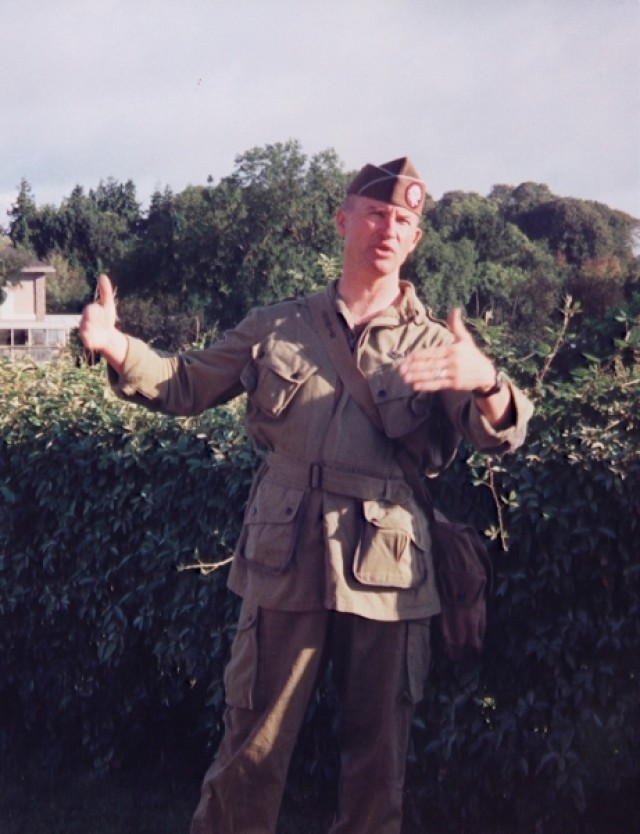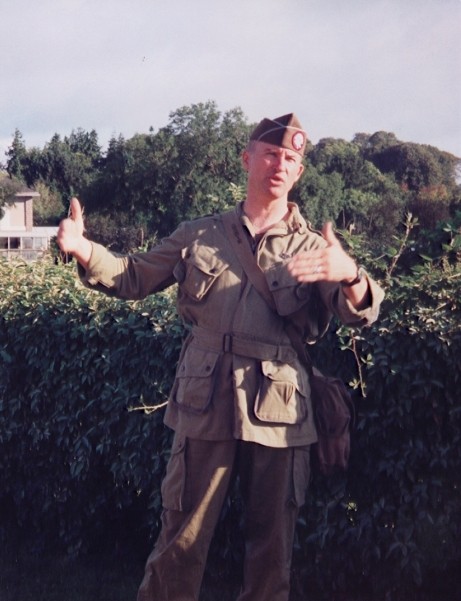FORT MONMOUTH, N.J. -- Along with being proclaimed the "Greatest Generation," the Soldiers of World War II may also qualify as the greatest souvenir hunters in history.
Take the fall of Cherbourg, France for example.
Captured German Gen. Karl Wilhelm von Schlieben complained incessantly of having to eat K-rations and the lack of a shower at the farmhouse where he was under guard.
But the ultimate indignation the German officer declared was the complete stripping of his uniforms of all braid and rank by trophy-seeking GIs.
More than a half century later, those Soldiers and souvenir hunters still proudly display their memorabilia and cherish the memories of how they were acquired.
Pete Leonard, 328th Infantry Regiment, returned home with two German pistols he discovered after the Battle of the Bulge.
He successfully smuggled them back from Europe to the United States, only to be threatened by a "shakedown" search the next morning.
"I literally went AWOL [absent without leave] from Fort Dix to get them home," said Leonard.
"I crawled under the fence, hitchhiked to the railway station and sat in a locked bathroom on the train just to avoid the military police until I made it to Penn Station."
Any visitor received by Merve Troutman, 82nd Airborne Division, is always treated to a viewing of his paratrooper uniform, jump boots, and helmet sporting a jagged hole where an enemy soldier made his mark. "But I lived to tell the story," Troutman said proudly.
A German swastika flag retrieved from Stalag VII-A near Moosburg, Germany still hangs in the home of World War II bomber pilot Martin Allain.
As the last American prisoner-of-war camp was liberated, Allain climbed the main flagpole and replaced the German flag with a Stars and Stripes he'd hidden from the Germans for almost three years.
"The story of how Grandpa climbed the flagpole and tore down the swastika was a great favorite with our children at bedtime," said Allain's wife, Lila.
Al Meserlin, Eisenhower's personal photographer in the last months of the war happened to grab a vacuum cleaner one day while photographing the Allied Supreme Commander.
"I stuffed it in the back of the jeep and to this day I can't imagine what I ever thought I was going to do with it," laughed Meserlin. "Luckily, Ike never noticed or said anything about it."
Stephen Mrozek, former national historian for the 82nd Airborne Division Association, says souvenir-hunting during conflicts, especially one as notable as World War II, isn't hard to understand.
He claims nothing brings veterans closer to the past than holding something tangible from a particular moment in time.
"When Soldiers pick that object up, even though it may be years later, a memory is triggered and they're reliving that adventure once more," said Mrozek.
It's a theory that makes perfect sense to Bob Wright, a 101st Airborne paratrooper who jumped in Normandy and retrieved his parachute for his bride's wedding dress.
"It might have been just Margaret and me at that altar, but I felt the presence of all my buddies that I jumped with in the Normandy invasion when I saw her walking down the aisle" said Wright.
Mrozek believes many veterans view their war experiences as a wakening, a moment in their lives that nothing else compares to, even surpassing marriage and children.
Especially by those involved in heavy fighting.
"The common denominator is combat," said Mrozek who has interviewed veterans from as far back as the Spanish American War to the present.
"Life becomes far dearer to those that have been close to death.
They come to cherish a souvenir or special token taken from that time that reassures them that they lived through," he said.
In some cases, the souvenir may be a treasured item a Soldier brings with him from home for good luck.
In the "Story of Dr. Wassell," a World War II movie released by Paramount Pictures in 1944, a young sailor named Hoppe has a small bag of Arkansas mud he's carried since the day he left his parent's farm.
"That's plain Arkansas mud," Hoppe says in the film.
"A piece of the USA that means heaven."
In contrast, it's foreign soil that many veterans regard as the ultimate memento.
In the film, "Saving Private Ryan," despite the fierce battle in progress on the Normandy beachhead, a Soldier is scooping up sand to add to his collection from Italy and North Africa.
Since Normandy reunions began, some beginning as soon as the war ended, thousands of veterans have headed for Omaha and Utah beach with a container for that very purpose.
"I didn't think to do it the first time," said Frank Gagliano, 101st Airborne who came in on D-Day plus one at Omaha Beach. "I was too busy trying to stay alive."
The desire to acquire souvenirs isn't harbored by just veterans, but a tradition that's been passed to their descendants as well.
John Gagliano visited Omaha Beach along with his father, Frank, on the 55th anniversary of the Normandy Invasion.
The sand he gathered that day has taken on a whole new meaning since his father is no longer living.
"I use it to remember him when he was so young. He and all those other Soldiers he served with. So many gave their lives and that's something that should always be remembered. That's what that sand is for," said Gagliano.
Retired Col. Bill Ridley, founder of BK Tours & Travel, sponsors Normandy tours every year.
As someone who lost a relative on Omaha Beach during the invasion, Ridley understands the sentiment of gathering sand and makes sure his guests are given ample time to explore the beaches, contemplate and gather that much sought after trophy.
"I always felt my uncle, Staff Sgt. William Becker, 18th Infantry Regiment, 1st Infantry Division, was a hero, and because of that I decided to pursue a military career," said Ridley. "Sand from those beaches is a way to memorialize those men forever where they stood together and were counted."
First Lt. Eric Dinoto reached a lifelong goal when he visited the five Normandy invasion beaches.
He spent several hours at Omaha Beach, even sprinkling salt water on his face as a means to enhance his understanding of D-Day. The only sand he gathered was from that beachhead since that's where the 29th Infantry Division landed, the unit he serves in today.
"As I was collecting the sand, I could swear I noticed a tinge of red to it, reminding me of the lives lost," said Dinoto.
Wanting to leave something in return, Dinoto buried his rank and uniform patch at the cliff base on Omaha Beach.
He felt that was appropriate since the ground has special meaning for the infantry.
"Soldiers come to love the earth because they spend so much time in it, and when involved with a major combat mission, they become a part of it," he said.
Other World War II souvenir junkies boast of military relics such as Yank magazines filled with extraordinary writings that describe in vivid detail battles and down time, the hopelessness of losing buddies that were closer than family, and the joyous tears of finally seeing the Statue of Liberty on their return.
In one New Jersey Veterans Center a huge poster of Yank's famous pinup girls decorates the walls.
Songs that good naturedly poke fun at World War II Army life called, "What Do You Do In The Infantry'" and "The Cranky Old Yank In A Clanky Old Tank," are also a big favorite as well as War Department Yank Swing Session records from The Armed Forces Radio Service.
In addition to Normandy sand samples, crickets (communication devices) and parachutes used by 82nd and 101st Airborne Division Soldiers the night of the invasion are also much sought after souvenirs.
Modern times have brought forth notable items such as Berlin Wall fragments and the infamous Saddam Hussein playing cards, but it's World War II memorabilia that continues to fascinate Americans.
Take the old P-38 can opener. Introduced in 1942, it was carried by thousands of GIs throughout the Second World War as well as Korea and Vietnam.
Remarkably, it still serves Soldiers today in Operations Iraqi Freedom and Enduring Freedom. As a result, it's hard to find any service member who doesn't have a unique story connected to "the most perfectly designed tool in history."
One World War II war bride proudly displayed her P-38 presented just over 65 years ago as an offer of marriage from a handsome young Soldier when nothing else was available.
"Since we were married over half a century, I think it's a pretty good souvenir," she said.
(Editor's note: This is the fourth story in a series featuring World War II novelties.)


Social Sharing